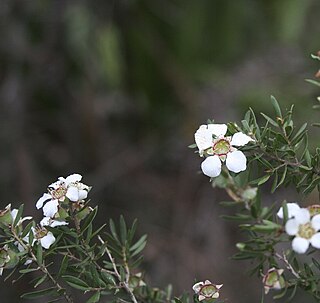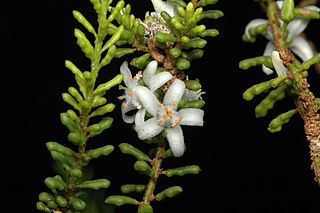
Thryptomene hexandra, commonly known as Palm Valley myrtle in the Northern Territory, is a species of flowering plant in the family Myrtaceae and is endemic to north-eastern Australia. It is an erect, much-branched shrub with linear to lance-shaped leaves and white flowers with six stamens.

Hibbertia aspera, commonly known as rough guinea flower, is a species of flowering plant in the family Dilleniaceae and is endemic to eastern Australia. It is an ascending or erect shrub with low-lying or scrambling branches, oblong to lance-shaped or egg-shaped leaves with the narrower end towards the base, and yellow flowers with four to six stamens in a single group, joined at the base.

Leptospermum polygalifolium, commonly known as tantoon, jellybush or yellow tea tree, is a species of shrub or tree of the family Myrtaceae that is endemic to eastern Australia, including Lord Howe Island. It has thin bark, elliptical leaves, white flowers arranged singly on short side shoots and fruit that remain on the plant for a few years.

Leptospermum juniperinum, commonly known as the prickly tea tree, is a species of broom-like shrub that is endemic to eastern Australia. It has narrow, sharply pointed leaves, white flowers usually arranged singly on short side shoots and small fruit that remain on the plant when mature.
Persoonia leucopogon is a species of flowering plant in the family Proteaceae and is endemic to Western Australia. It is an erect to low-lying shrub with branchlets that are densely hairy when young, narrow oblong to narrow elliptic leaves and yellow or greenish yellow flowers borne singly or in groups of up to four on a rachis up to 2 mm (0.079 in) long.

Leptospermum gregarium is a species of shrub that is endemic to eastern Australia. Its young stems are hairy the leaves are egg-shaped to lance-shaped with the narrower end towards the base, the flowers are white and arranged singly or in pairs on short side branches and the fruit remain on the plant at maturity. It usually grows in dense stands in swamps or along rocky creeks in high altitude place in northern New South Wales and south-eastern Queensland.
Leptospermum minutifolium, commonly known as the small-leaved tea-tree, is a species of shrub that is endemic to eastern Australia. It has relatively small egg-shaped leaves, white flowers borne singly on the ends of branches and fruit that remains on the plant.

Leptospermum semibaccatum is a species of low, dense shrub that is endemic to eastern Australia. It has egg-shaped to narrow elliptical leaves with a blunt tip, white or pink flowers and hairy, flat-topped fruit that falls from the plant shortly after the seeds are released. It grows in poorly-drained soil in coastal heath.
Philotheca cuticularis is a species of flowering plant in the family Rutaceae and is endemic to Queensland. It is a rounded shrub with small, crowded leaves and small white flowers arranged singly on the ends of branchlets.

Philotheca pachyphylla is a species of flowering plant in the family Rutaceae and is endemic to Western Australia. It is a small shrub with fleshy, oblong, prominently glandular-warty leaves and white flowers arranged singly in leaf axils.

Philotheca queenslandica is a species of flowering plant in the family Rutaceae and is endemic to south-eastern Queensland. It is a wiry shrub with elliptic to egg-shaped leaves with the narrower end toward the base and densely crowded near the ends of the glandular-warty branchlets, and cream-coloured flowers tinged with pink and arranged singly in leaf axils.
Philotheca rhomboidea is a species of flowering plant in the family Rutaceae and is endemic to the south-west of Western Australia. It is a small undershrub with thick, broadly elliptic to round leaves and white to pale pink flowers arranged singly or in twos or threes at the end of branchlets.
Goodenia kakadu is a species of flowering plant in the family Goodeniaceae and is endemic to the Northern Territory. It is a prostrate herb with narrow oblong leaves in rosettes on stolons, and small dark red flowers arranged singly in leaf axils.

Goodenia lamprosperma is a species of flowering plant in the family Goodeniaceae and is endemic to northern Australia. It is an annual or perennial herb with linear to lance-shaped leaves sometimes with teeth on the edges, and racemes of yellow flowers.

Teucrium albicaule, commonly known as scurfy germander, is a species of flowering plant in the family Lamiaceae, and is endemic to inland areas of Australia. It is a hoary, perennial herb that spreads by root suckers, forming dense stands. The leaves are trifoliate and the white flowers are arranged singly in leaf axils.
Goodenia odonnellii is a species of flowering plant in the family Goodeniaceae and is endemic to northern Australia. It is an erect to low-lying herb with oblong to egg-shaped leaves with toothed or lyrate edges, and racemes of yellow flowers.

Goodenia pilosa is a species of flowering plant in the family Goodeniaceae and is native to northern Australia and to parts of Asia. It is a prostrate to low-lying herb with erect hairs, narrow oblong to narrow elliptic leaves at the base of the plant and racemes of yellow flowers with a purplish base.
Goodenia pumilio is a species of flowering plant in the family Goodeniaceae and is native to northern Australia and New Guinea. It is a prostrate, stolon-forming herb with egg-shaped to lance-shaped leaves in rosettes, and racemes of small, dark reddish-purple flowers.
Goodenia quadrifida is a species of flowering plant in the family Goodeniaceae and is endemic to a restricted part of the Northern Territory. It is an ascending herb with glabrous foliage, narrow oblong to lance-shaped leaves at the base of the plant and racemes of purplish-brown flowers.
Bossiaea alpina is a species of flowering plant in the family Fabaceae and is endemic to a small area in south-eastern Victoria, Australia. It is a diffuse shrub with oblong to elliptic leaves and bright yellow flowers arranged singly on the ends of branchlets.










